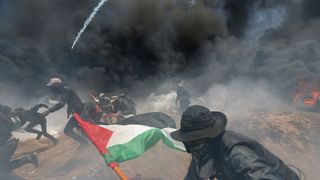It was obvious that it was going to be a black day.
Large crowds had been arriving at the border from mid-morning.
We watched them trudge in groups across the fields of watermelon, which run alongside the security fence with Israel.
Clouds of smoke from the burning tyres belched into the blue sky – the smog was supposed to provide a curtain of cover from the sniper fire.
Israel had sent large numbers of soldiers to reinforce the existing line of troops.
The IDF had warned, with leaflet drops from the air, that anyone approaching the fence was putting themselves at risk.
It made no difference.
At one point, every few minutes we’d hear the crack of a rifle. Sometimes it was close, sometimes it was far – but each time it would be followed with the sight of someone either falling down, or already writhing in pain on the ground.
But the bullets didn’t seem to frighten anyone.
Men, women, teenagers and sometimes children would simply stay where they were, or would keep moving forwards.
Israel has portrayed the protests as a Hamas project; it claims it is sending people to the fence knowing they will get hurt to provoke international outrage against the Jewish state.
It also accuses the group of using the demonstrations as a cover for terrorism.
I asked dozens of protesters if this was the case. Some shook their heads, others laughed. But all of them said that all of Gaza was supporting the movement.
By midday the field hospitals were already overwhelmed, casualty after casualty arrived, sometimes three people all with gunshot wounds in one ambulance.
Gaza’s health system was already creaking but medics are now warning it is at the point of collapse.
Tomorrow there will be another day of protest when the Palestinians mark the ‘Nakba” – the catastrophe for them which befell their people when Israel was created in 1948.
Seventy years of conflict and still there is no end.
From – SkyNews




